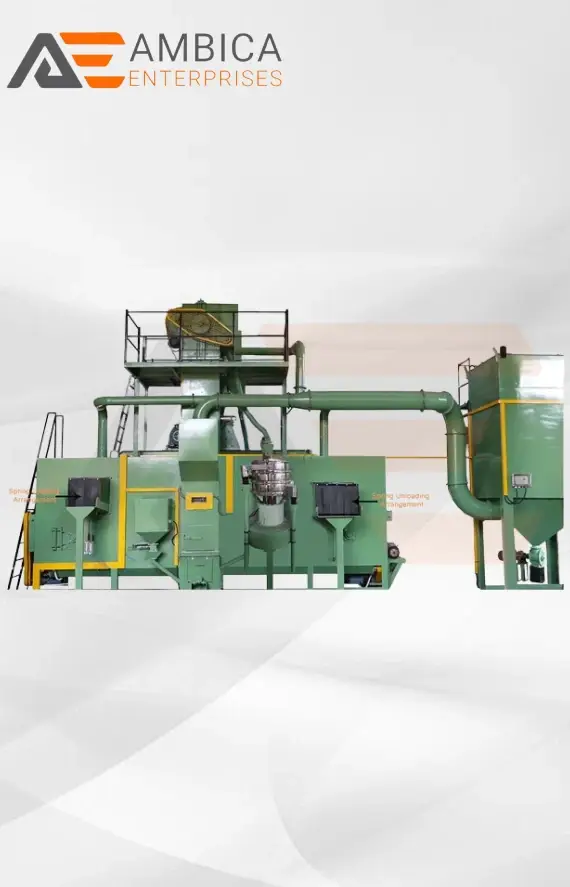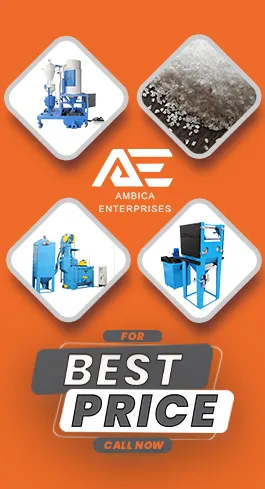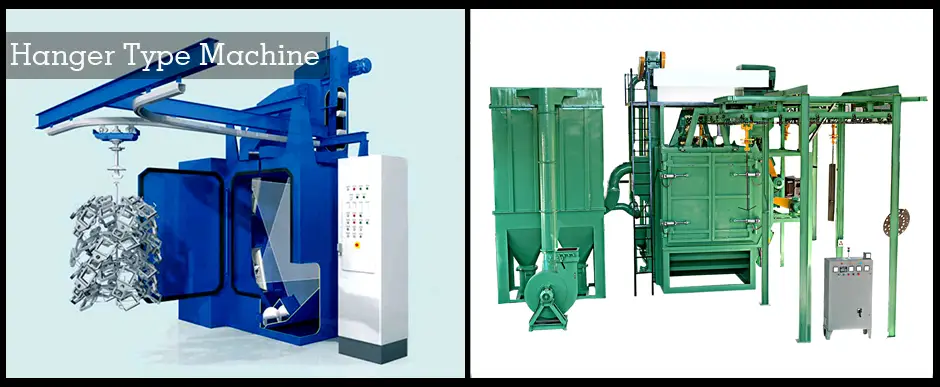
Shot Peening Machine
Price Range : ₹ 1.50-7Lakh
Air Transport
Sea Transport
Land Transport
- Shot peening machine is utilized in a variety of sectors to enhance the surface qualities of components, including medical, aerospace, & automotive.
- In addition to these applications, shot peening can be utilized to remove sand in foundries, as well as to decorate, descal, & polish castings for engine blocks & cylinder heads.
- The method is also commonly employed to reduce tensile strains caused by work hardening in airplane repairs.
- Shot peening machine can also be employed for cosmetic purposes, since it creates a roughness on the surface that scatters light more efficiently than sand blasting.
5 Star Rating by our Precious Clients
- More Details
- Call Now
- Get Latest Price
![]()
Leading Supplier & Exporter
![]()
Trustseal Verified
![]()
ISO Certified
![]()
Manufacturer
Introduction of Shot Peening Machine
Shot peening machine is an exclusive mechanical process that is utilized broadly in applications where the interpretation of certain elements must be improved above conventional design limitations. Shot peening equipment is a casting process that produces a compacted layer and alters the characteristics of metal. This procedure is extremely different from shot blasting machine. Shot blasting is used to prepare or clean material, whereas shot peening is a method that requires careful media selection and concentration. It is a stressing procedure performed on the surface of metals. It employs steel shots that are fast-tracked on the surface, resulting in no dust as compared to shot blasting.
The shot peening process derives from the same principle certain early blacksmiths employed when they continued to hammer (peen) a hot forged iron & steel instance long behind it cooled making it a tougher & more durable product.
That art has been refined into a closely controlled manufacturing process that is capable of obtaining results in improving product fatigue life in a way that is not attainable by any other similar production means. It is used successfully on mechanical power transmission and other components for the aeronautical, automotive & industrial fields as well as for many other applications whether constructed of ferrous & non‐ferrous materials.
Shot Peening Process
Shot peening is a cold working procedure involving bombarding a component's exterior accompanied by tiny spherical particles known as steel shot. Each bit of shot that smashes the material serves as a tiny peening hammer, assembling a little indentation & dimple on the exterior. To form the dimple, the material's exterior fibers must give under tension. Below the exterior, the fibers endeavor to recover the surface's original form, resulting in a hemisphere of cold-worked material certain is strongly strained in compression. Overlaying dimples form a consistent coating of metal under residual compressive pressure. It is commonly understood certain fractures do not originate & propagate in a compressively strained zone. Because almost all exhaustion & pressure erosion failures occur at the exterior of a component, compressive stresses caused by shot peening give significant improvements in component life. Shot peening assembles a maximum compressive residual pressure at & underneath a component exterior whichever is at least half the yield strength of the material existing peened. Many materials' surface hardness will increase as a outcome of the coldworking action of shot peening.
The benefits acquired from shot peening are the consequence of the compressive stress & cold working generated. Compressive stresses enhance resistance to fatigue failures, corrosion fatigue, stress from deterioration cracking, hydrogen-assisted cracking, fretting, galling, & erosion produced by cavitation. Cold working provides benefits such as employment hardening, intergranular erosion resistance, exterior texturing, porosity closure, & coating bond testing. Shot peening is used to produce metal pieces using compressive pressures as well as cold-worked effects.
Tensile tension is a common denominator in the majority of long-term failure mechanisms. These stresses might be caused by external loads & residual stresses from manufacturing operations like welding, grinding, & machining. Tensile forces seek to stretch & remove the surface apart, whichever might eventually lead to crack formation. Compressive stress squeezes the surface grain boundaries together, greatly delaying the onset of exhaustion cracking. fracture propagation is greatly diverted in a compressive thermal spray coatings, hence increasing its depth enhances fracture resistance. Shot peening is the most cost-effective & feasible means of maintaining surface residual compressive stresses.
Shot peening equipment is a very effective procedure for increasing the usefulness life of a comprehensive coverage of metallic components. Its advantages could just be fully seen if you grasp the principles concerned in shot peening. Provides a complete overview of these concepts, including fundamental mechanics, peening abrasive media, residual pressure distributions, coverage, & equipment. The primary condition for residual stress is the formation of a compressively strained coating on the surface. To optimize the residual stress profile for individual components, peening parameters must be properly controlled. Presents and examines the many elements certain affect the residual stress profile.
Paint spraying serves as an excellent comparison for shot peening. Useful because paint spraying is a commonly known technique along identical fundamental principles. Roughly spherical steel shots are projected onto a surface along the goal of providing uniform, defined coverage (using "masking" to prevent undesired coverage). Compressed air accelerates the bits as they exit a gun. A spray cone is created, & the intensity (particles traversing a unit area per unit time) diminishes with the square of the distance from the gun to the jobpiece. The rate of paint application is proportional to the volume of paint certain emerges from the gun per unit time. We could utilize many thermal spray guns at the same time to produce huge components. Either the jobpiece is moved relative to the static paint guns, or vice versa. To ensure consistent paint coverage on a particular component, process control parameters must be maintained.
Shot peening is generally carried out in a shot blasting cabinet to confine the shot & the dust certain occurs as an outcome of the process & to facilitate the collection & reuse of the steel shot. In full mass production mode, the work is automatically carried in & out of the enclosure by mechanical means with the area to be positioned in an easily accessible location.
Steel shot may be propelled by air, water, or by a shot blasting wheels with velocities in the order of 200 fps. Air or water systems propel the shot through a nozzle while the wheel method slings the shot abrasive media using a rotating vaned device.
The area impacted by the shot stream is called the shot pattern. In the case of a pneumatic delivery machine, steel shot is sprayed by a sand blasting nozzle covering a circular target area of about 2 or 3 inches in diameter depending on nozzle size and distance to the work. The shot pattern from a wheel is fan shaped with the included angle of about 40 degrees, & width somewhat greater than the wheel width. The length & width of the pattern is governed by the distance of the work to the wheel.
Shot peening machines may be categorized into two primary categories relying on the system employed to provide & propel the blast to the target area. They are:
- Air Blast Machines
- Centrifugal Blasting Machines
A standard shot peening machine is assembled up of the following major systems:
- A cabinet to contain the job piece including assorted shot delivery & recovery as well as dust & debris removable systems.
- Conveyer system to transport the employment in & out of the shot blasting cabinet & a mounting device to position the work to be shot peened.
- A shot handling system for producing shot & accurately propelling it to the target.
- A device to return the shot certainly has been utilized in the peening process to be recycled.
- Separator to remove broken or undersized recycled steel shot.
- Device to replace broken or undersized steel shots accompanied by new material.
- System to collect & remove dust & debris from the cabinet.
Shot Peening Machine Advantages
- Shot peening machine provides enhanced strength & fatigue resistance, especially when processing complicated geometric pieces.
- The procedure is well-known & reasonably affordable, with extensive research & quality control to assure its efficacy. In addition, the media & equipment are easily accessible.
- Aside than increasing material properties, shot peening may deliver a pebbly surface, whichever could be useful in some applications.
Shot Peening Machine Price
Ambica Enterprises is one of the best shot peening machine manufacturers in India. Shot peening machine price depends on the types and sizes of shot peening equipment in India. Our shot peening machine price is low compared to others. We also offer abrasive blasting machines, sand blasting machine, airless shot blasting machines, air operated shot blasting machines, stone shot blasting machines, granite engraving machines, shot blasting wheels, abrasive blasting nozzle, sand blasting hoses, etc.

